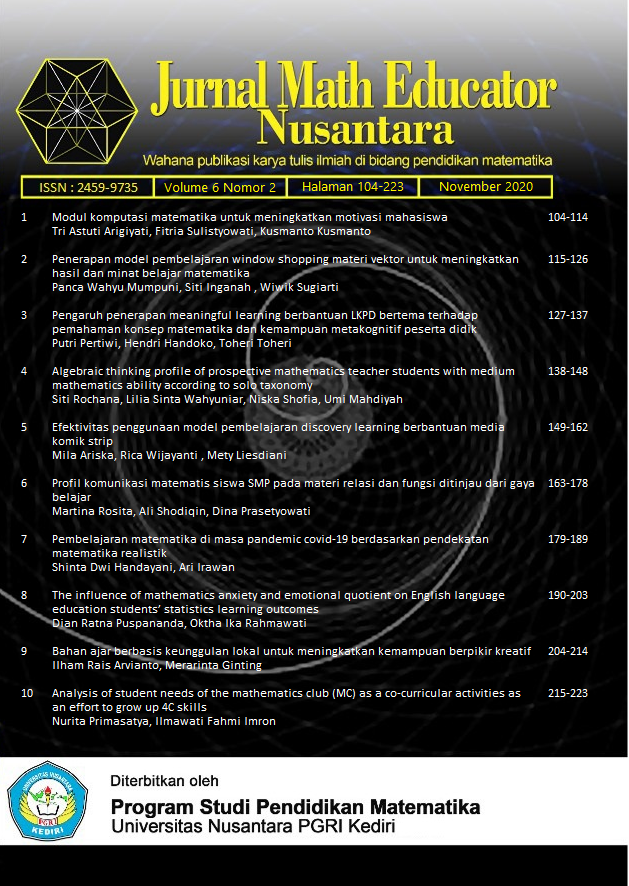Algebraic thinking profile of prospective mathematics teacher students with medium mathematics ability according to solo taxonomy
DOI:
https://doi.org/10.29407/jmen.v6i2.14742Keywords:
Algebraic Thinking Profile, Mathematics Teacher Candidates, Medium Math Ability, SOLO TaxonomyAbstract
This study aims to describe the algebraic thinking profile of prospective mathematics teacher students according to the SOLO taxonomy. The research was conducted at the Nusantara University PGRI Kediri. The research subjects were students who are prospective mathematics teachers with moderate or average abilities. Subjects are selected based on course scores and information from several lecturers who are teaching the subject. Besides that, the willingness and openness of the subject is also a consideration for choosing this subject. The instrument used in this study was a matter of algebraic problems. The method used is a qualitative method which refers to the written test and interview. The questions that are done consist of tests of algebra problems for pattern components and algebra problem tests for variable components. The results showed that students of prospective mathematics teachers with moderate mathematical abilities met the indicators of algebraic thinking, namely being able to find certain terms in a given pattern but were unable to generalize the given pattern and could not understand variables as general form numbers in algebraic form.
References
Booker, G. (2009). Algebraic Thinking: Generalising Number and Geometry to Express Patterns And Properties Succinctly. Algebraic Thinking: Generalising Number and Geometry to Express Patterns and Properties Succinctly, 10–21.
Dindyal, J. (2004). Algebraic thinking in geometry at high school level: Students ’ use of variables and unknowns. 27th Annual Conference of the Mathematics Education Research Group of Australasia, June 2004, 183–190. http://hdl.handle.net/10497/14365
Gagnon, J. C., & Maccini, P. (2001). Preparing Students with Disabilities for Algebra. TEACHING Exceptional Children, 34(1), 8–15. https://doi.org/10.1177/004005990103400101
Herstein, I. N. (1964). Topics in algebra “An algebraic system can be described as a set of object together with some operations for combining them.” Ginn and Company.
Irawati, S., Studi, P., Matematika, P., Madura, U., & Madura, U. (2006). Analisis Kesalahan Mahasiswa Calon Guru Matematika Dalam.
Jamil, A. F. (2017). Peningkatan Level Berpikir Aljabar Siswa Berdasarkan Taksonomi SOLO Pada Materi Persamaan Linier Melalui Pemberian Scaffolding. JURNAL ILMIAH MANDALA EDUCATION (JIME), 3(1), 175–181.
Kamol, N. (2005). A Framework in Characterizing Lower Secondary School Students’ Algebraic Thinking. Unpublished Doctoral Dissertation). Srinakharinwirot University, Bangkok.
Kriegler, S. (2008). Just what is algebraic thinking. Retrieved September, 10, 2008.
Lim, H. L., & Noraini Idris. (2006). Assessing algebraic solving ability of form four students. International Electronic Journal of Mathematics Education, 1(1), 55–76.
Linsell, C., Savell, J., Johnston, N., Bell, M., Mcauslan, E., & Bell, J. (2007). Early algebraic thinking : links to numeracy.
Moleong, L. J. (2007). Metodologi penelitian kualitatif edisi revisi. Bandung: PT Remaja Rosdakarya, 103.
Napfiah, S. (2016). Berpikir Aljabar Mahasiswa Dalam Menyelesaikan Masalah Berdasarkan Taksonomi Solo Ditinjau Dari Kemampuan Matematika. KALAMATIKA Jurnal Pendidikan Matematika, 1(2), 171. https://doi.org/10.22236/kalamatika.vol1no2.2016pp171-182
Ni’mah, K. (2016). Kesadaran struktur matematis anak pra sekolah pada aktivitas pola. Jurnal Math Educator Nusantara: Wahana Publikasi Karya Tulis Ilmiah Di Bidang Pendidikan Matematika, 2(1).
Ruggiero, V. R., & Ruggerio, V. R. (2004). The art of thinking: A guide to critical and creative thought. Pearson/Longman.
Sugiman. (2015). Peran Guru Matematika dalam Mewujudkan Siswa yang Konstruktif melalui Pemecahan Masalah. Seminar Nasional Matematika Dan Pendidikan Matematika UNY, 9–18.
Wahyuniar, L. S., Shofia, N., & Rochana, S. (2018). Proses Berpikir Aljabar Siswa Mts Kelas VIII Menurut Taksonomi Solo Ditinjau Dari Perbedaan Gender. Jurnal AKSIOMA: Jurnal Program Studi Pendidikan Matematika, 7(2), 275–282.
Downloads
Published
Issue
Section
License
Authors who publish with this journal agree to the following terms:
- Copyright on any article is retained by the author(s).
- The author grants the journal, the right of first publication with the work simultaneously licensed under a Creative Commons Attribution License that allows others to share the work with an acknowledgment of the work’s authorship and initial publication in this journal.
- Authors are able to enter into separate, additional contractual arrangements for the non-exclusive distribution of the journal’s published version of the work (e.g., post it to an institutional repository or publish it in a book), with an acknowledgment of its initial publication in this journal.
- Authors are permitted and encouraged to post their work online (e.g., in institutional repositories or on their website) prior to and during the submission process, as it can lead to productive exchanges, as well as earlier and greater citation of published work.
- The article and any associated published material is distributed under the Creative Commons Attribution-ShareAlike 4.0 International License














